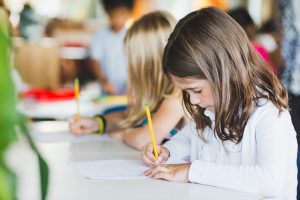Lower Elementary 1st - 3rd Grade
Young elementary children ages 6-9 are fascinated by stories: stories of animals; stories of the origins of things; stories of heroic accomplishments. They love to ask big questions. Much of the lower elementary curriculum is designed to help children explore their natural questions about their place in the world. The story, geography, biology and physical science curricula examine broad concepts and provide a framework for more abstract and in-depth study in later years.
Curriculum
Our Lower Elementary language curriculum offers a balanced approach to literacy. Children develop their reading by writing poems, stories and reports; they improve their composition skills by reading and appreciating literature. Teachers, children, and peer reviewers work collaboratively on the student’s own written piece to compose, edit, revise, refine, and share in the creative process. In the Lower Elementary Program, children continue to develop both encoding and decoding skills through the use of Montessori materials and a classroom environment rich in reading materials.
Mathematics Curriculum
The Montessori math materials offer a tangible foundation upon which mathematical thinking can grow. During this period, children develop greater ease with number operations and properties and more experience with the application of mathematical knowledge in problem solving. Our students explore concepts integral to arithmetic operations and plane geometry. They also memorize basic math facts and solve problems. Eventually, the concrete materials give way to abstract calculations.
Geography Curriculum
The geography curriculum includes physical, political, economic and human geography. The Elementary curriculum begins with the first of five Great Lessons. This lesson is the Story of the Beginning of the Universe, and introduces students to the wonders of all sciences, most specifically geography.
Science Curriculum
The Story of the Coming of Life, the second of the five Great Lessons, introduces the study of botany, zoology and ecology. Lessons in botany include study of the parts of the plant – leaf, root, stem, flower, fruit and seed – as well as plant classification. Lessons in zoology include the study of vertebrates and invertebrates, animal classification, and body systems and classes.
Lessons in human anatomy begin with the importance of the flow of blood in our bodies. Lessons in ecology introduce students to the interconnectedness of all living things and the part they play in the preservation of the planet and its species. An introduction to chemistry and physics prepare the students for the challenges of the Junior High science curriculum.
History Curriculum
The Great Story of Human Beings, the third of the five Great Lessons, introduces the development of humans throughout history. Lessons in history include the study of natural history, human history and the study of civilizations. Students learn about human inventions for the recording of time.
Foreign Language Curriculum
The Elementary child is ready for a formalized study in a foreign language, as he or she has had sensorial experiences in many languages, reads and writes in a native language, and is using abstraction as a common exercise in learning. Spanish is the chosen language of Arbor Montessori School curriculum.
Spanish in the Elementary class is taught as an integrated part of the curriculum. The children learn the Spanish language in relation to the study of language, math, history, zoology, botany, geometry and geography. Spanish in the Elementary classroom is approached through the study of grammar, sentence analysis and word study in language. History includes further study of the fundamental needs of humans as well as the history of language itself.
Botany, zoology and geometry are explored through the addition of Spanish names to the existing nomenclature. Political and physical geography easily lend themselves to the study of Spanish-speaking countries and cultures. Studying the history of communication in numbers and famous Spanish-speaking mathematicians is part of the integration of Spanish into the math area.
Physical Education Curriculum
Physical Education program offers many avenues for the mental and physical energies of our students. Activities for all children include body awareness, fitness, stretching, cooperative games, taking turns, listening skills and sportsmanship.
Activities from team games to fitness regimes invite children to test their own potentials and to challenge themselves to reach continually for higher objectives. Those same activities invite creative thinking and social awareness as well as cooperation and awareness of good team behavior.
The Physical Education program maintains emphasis on independence, freedom and discipline, and respectful interactions with the children. The children enjoy a consistency in the approach to class management and in the approach to their individual development.


